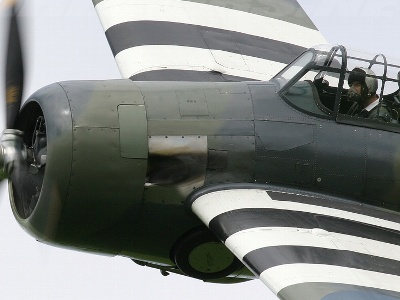
FM-2 Wildcat Hasegawa 1/72
Last Update 8/5/2016
 |

|
|
Recently, I got original factory drawings of FM-2 from "The AirCorps Library". And finally I found the total length is 28ft7-7/32in (including spinner) in a FM-2 Three View General Arrangements. Drawings of F4F-4 (or FM-1) were not included in the AirCorps Library, but I got drawings of the nose cowl of the Twin-Wasp model from other source. Then the total length of F4F-4 could be estimated as 29ft2.8in (including spinner; the length of the spinner have a margin of error). |
F4F-4
| FAOTW | 8,715mm(28ft7in) |
| D&S (F4F-3) | 8,773mm(28ft9-3/8in) |
| In Action No.84 | 8,839mm(29ft) |
| In Action No.191 | 8,763mm(28ft11in) |
| Factory drawings | 8,920mm(29ft2.8in approx) |
FM-2
| FAOTW | 8,800mm(28ft10in) |
| In Action No.84 | 8,763mm(28ft9in) |
| In Action No.191 | 8,814mm(28ft11in) |
| Factory drawings | 8,718mm(28ft7-7/32in) |
|
|
|
The outer wing of F4F is connected to the inner wing at the point "C". This means that the outer wing is fixed by three points of A, B and C. The latter half of the outer wing is free. On the other hand, the outer wing of F6F is connected at the rear beam. TBF Avenger is the same mechanism as F4F. The outer wing is fixed with the rod to the horizontal fin in folding mode. |
|
|
|
|
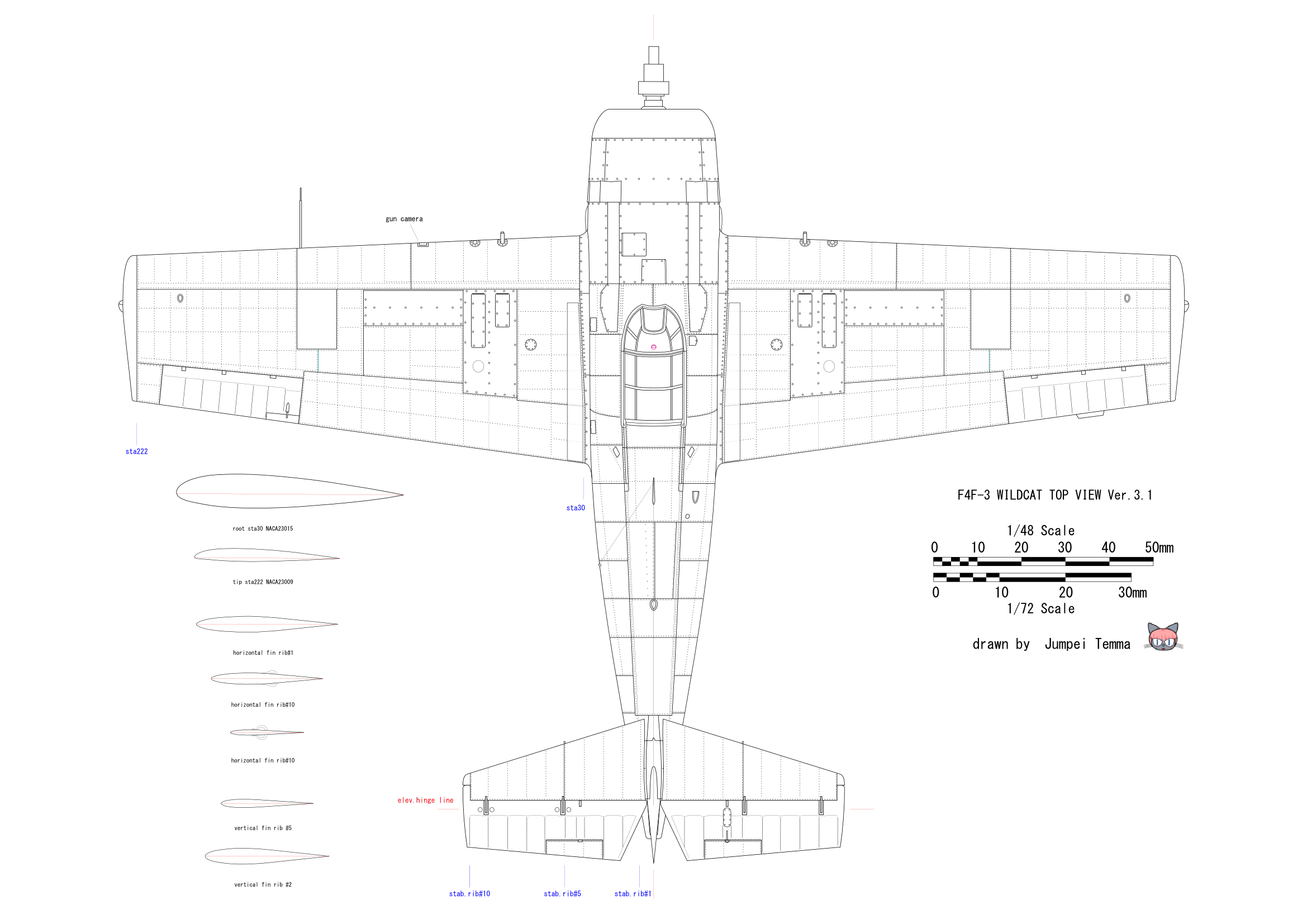
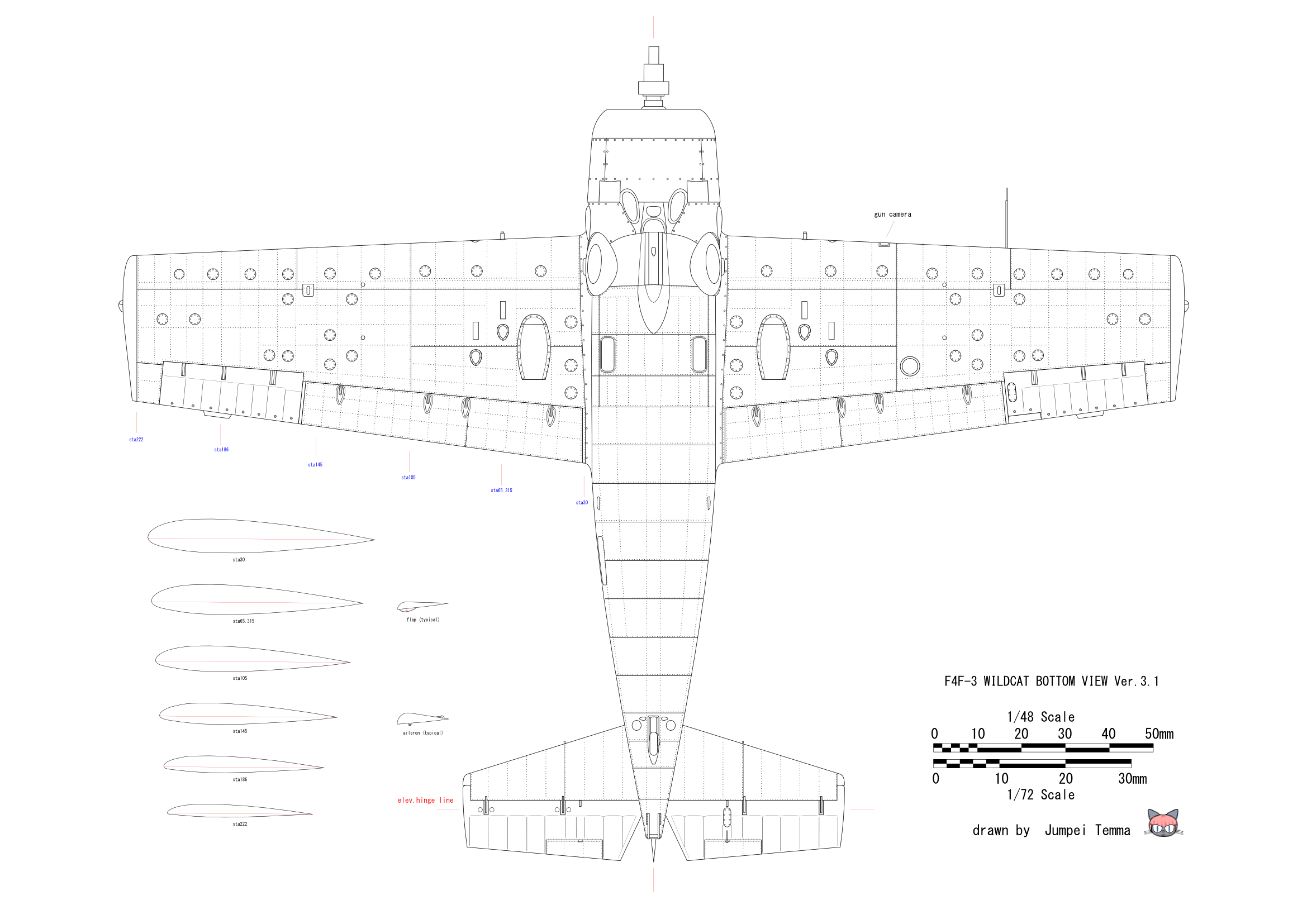
|
|
 This is restored FM-2. See the nose ridge line. |
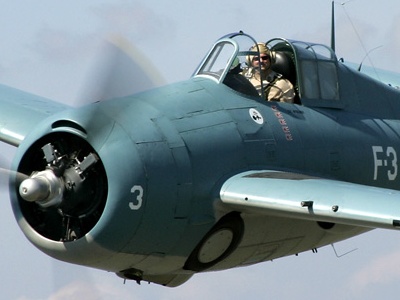 This is restored F4F-3. Panel lines show cross sectional shapes. |
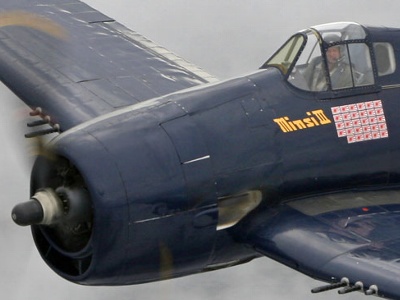 The nose ridge line of F6F is rather roundish. |
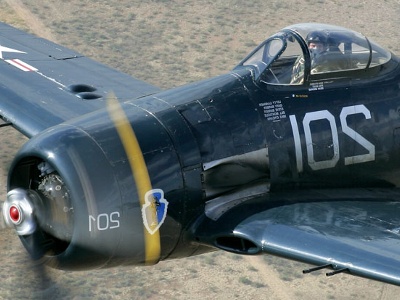 F8F is most prominent. |
|
|
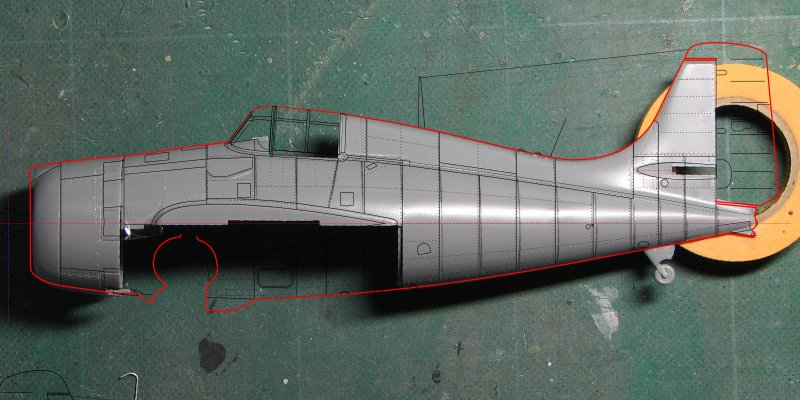 |
|
|
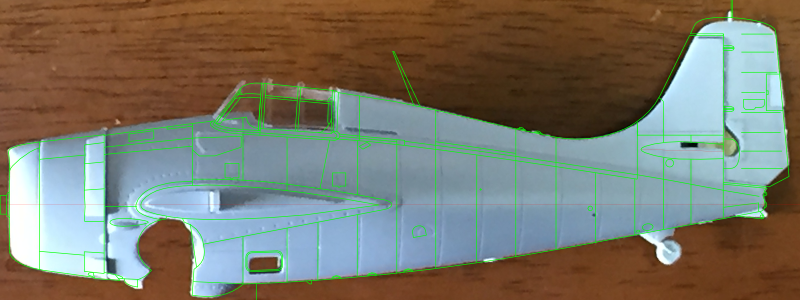 |
|
The engine of FM-2 is replaced to Cyclone R-1820. The new engine cowl was from Hasegawa SBD Dauntless. This kit cowl parts were a little large in the diameter. So they were divided into four parts and glued again. The leading edge is sanded to round the curve. The cockpit was moved backward by 1mm (0.04"). The True Details resin cockpit parts were set in the fuselage. Shims of styrene sheet were inserted to adhesive line of the fuselage parts to increase the diameter of the fuselage. Kit fuselage parts were bent to enlarge the height of the fuselage. The tail fin was extended using another kit parts. |
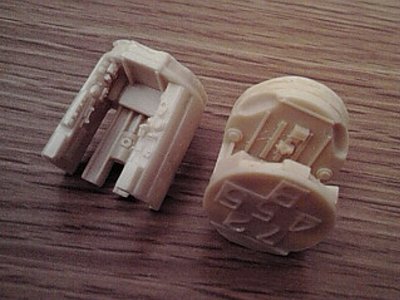 These are True Detail TD72455 resin cockpit and gear bay parts. The instrument panel and seat are included. |
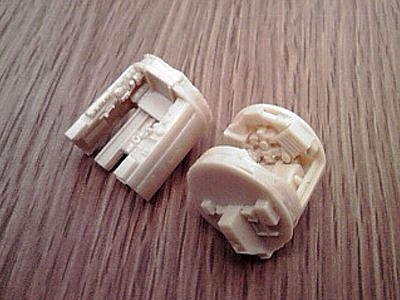 These parts are for F4F-4. So the intercooler is molded and it is different from FM-2. But I didn't correct. |
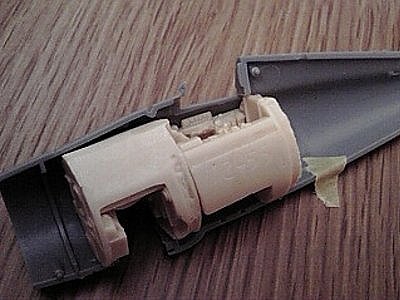 |
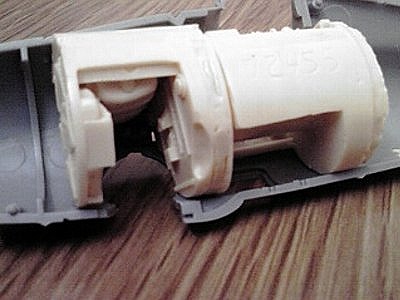 The lower window is visible from the cockpit. But the window is covered with metal sheet in FM-2. |
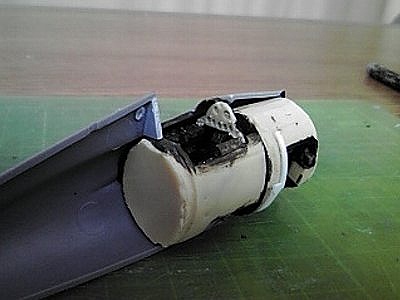 The instrument panel is glued and painted. |
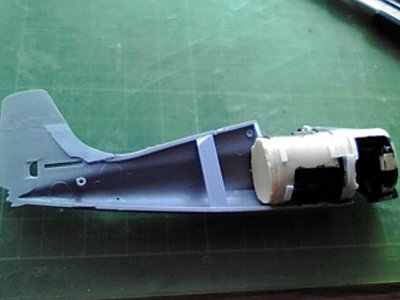 The prop of thick styrene sheet was inserted. |
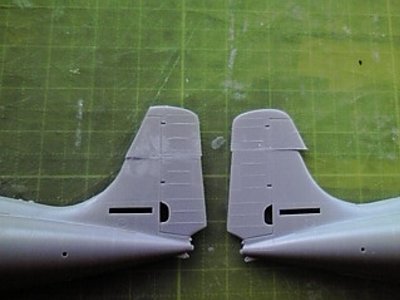 The tail fin is extended. The adhesive lines of the left and right parts are staggered to ensure the strength. |
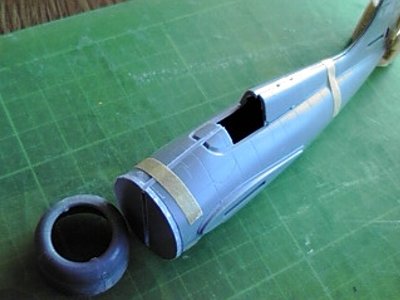 The styrene sheet shim is inserted. The fuselage front is extended 1mm (0.04") with styrene sheet. |
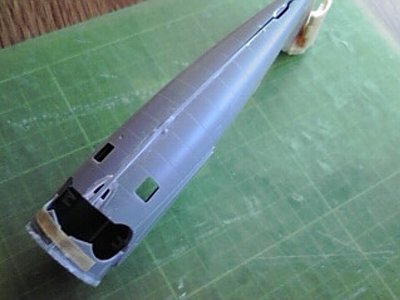 The shim is inserted lower fuselage as well. |
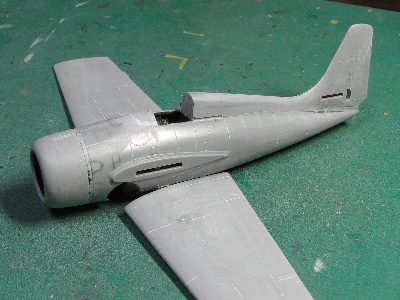 The construction or the fuselage is finished. |
|
|
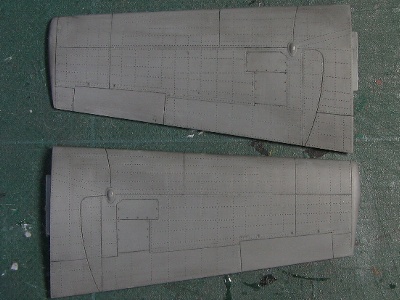 |
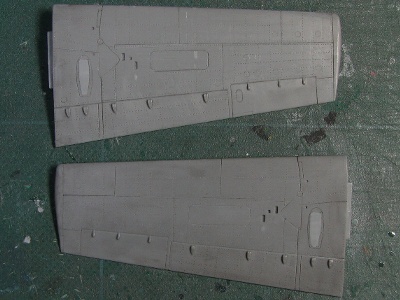 |
|
|
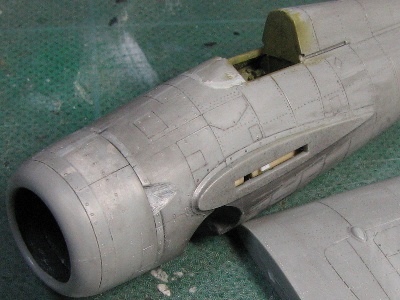 Engraving of panel lines and rivets was finished. |
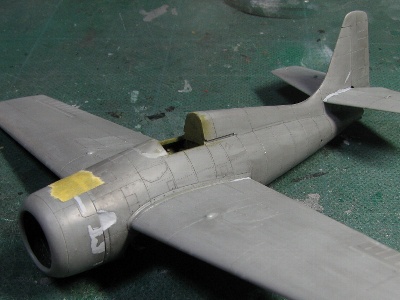 The wing and horizontal fin were glued to the fuselage. |
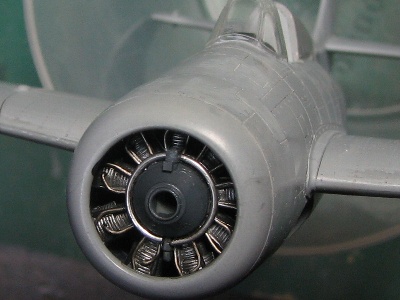 The Cyclone R-1820 engine was from Hasegawa SBD. |
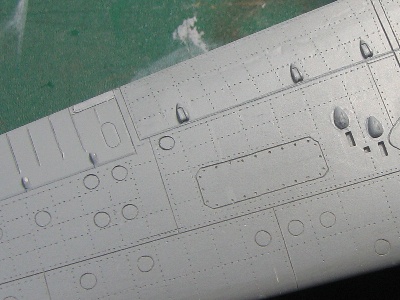 Small blisters had been cut from kit wing parts and attached again. |
|
|
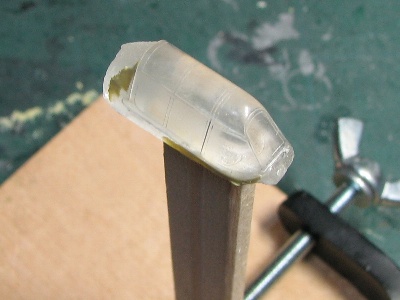 The kit canopy was used for the wooden mold. |
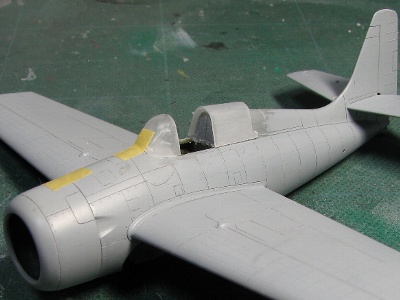 Acrylic sheet was heat formed, cut, trimmed and fit to the fuselage. |
|
|
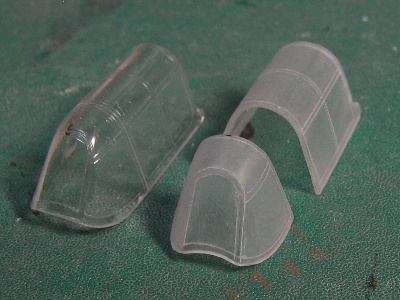 The canopy frame was engraved with handmade double needles. Two sewing needles were glued on a rod of plastic sheet. |
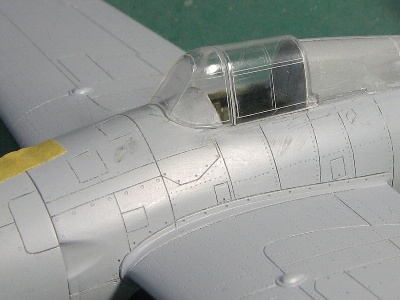 Heat formed acrylic sheet was sanded with fine sand paper. Then it was polished with rubbing compound. |
|
|
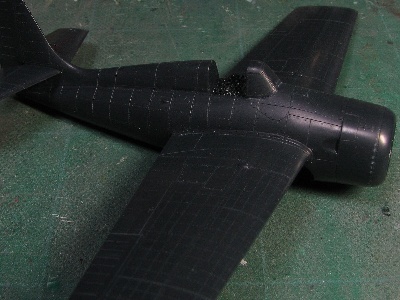 GSB was sprayed and the surface was polished with Raplos. |
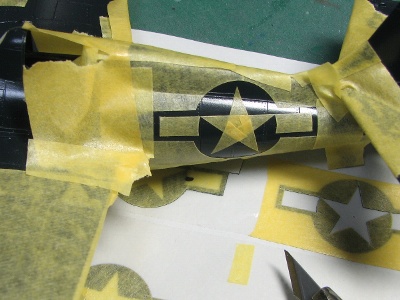 The fuselage insignia was painted. |
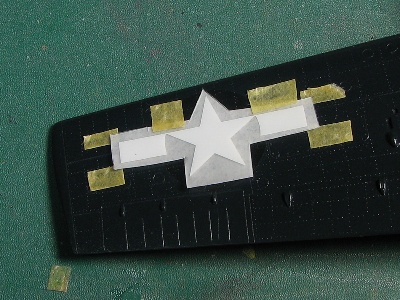 The wing insignia was dry decals. The position was carefully adjusted with masking tape. |
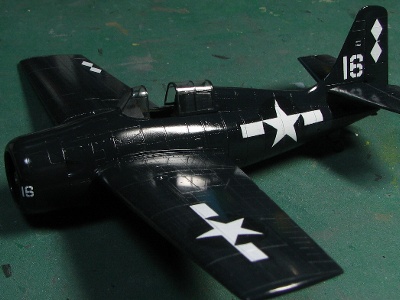 Unit markings were dry decals as well. |
|
At first, I applied four-leaf clover of USS Petrof Bay VC-93. But after applying dry decals, I found the design of the clover was mistaken. So I removed dry decals and re-applied backup dry decals. Finally, the markings is Lt. McElroy's aircraft number 16 of USS Sargent Bay VC-83 (VC-79 in other reference), in 1945. After applying dry decals, clear varnish was sprayed, then the surface was polished with Mr. Raplos #6000 to #8000.
|
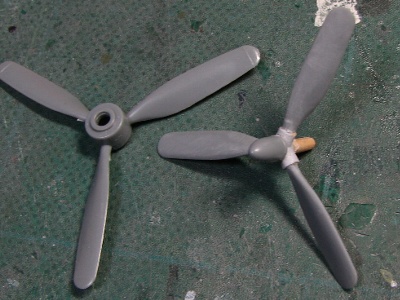 The propeller was scratch-built. Paddle blades were from Tamiya Mosquito. The shape and diameter were corrected. There are two types of spinner as for FM-2. The late style shell shape spinner was from Tamiya P-47. |
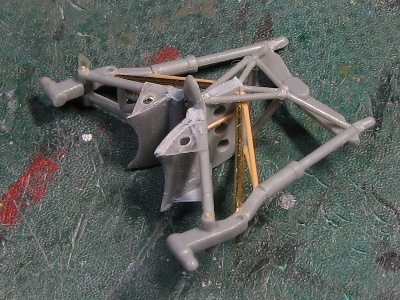 The trussed structure was added on the kit gear parts. I mistook the number of the holes on the center beam. |
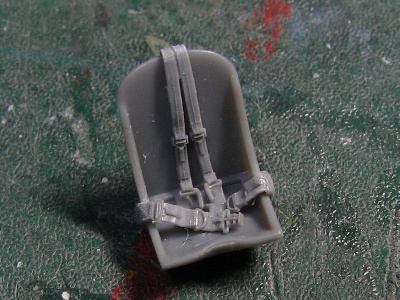 The seat was from Tamiya P-47 as well. The seat belt was from Fine Molds Nano Aviation. |
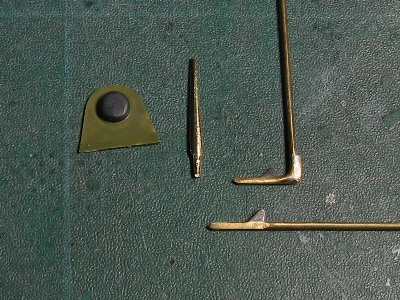 There are two types of the head pad and bullet proof board as well. My model features the late style. |
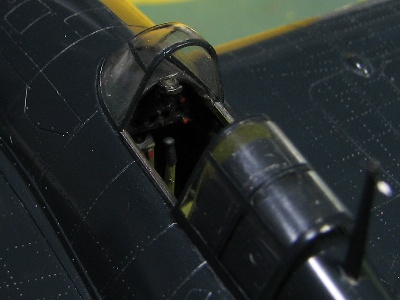 The gun sight is from Quick Boost resin parts. |
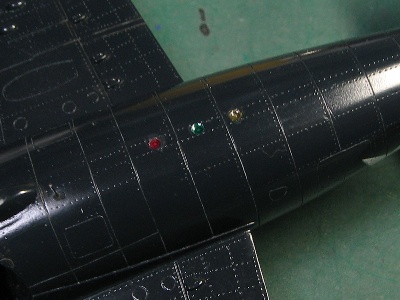 Navigation lights are depicted with UV Clear resin. |
|
|
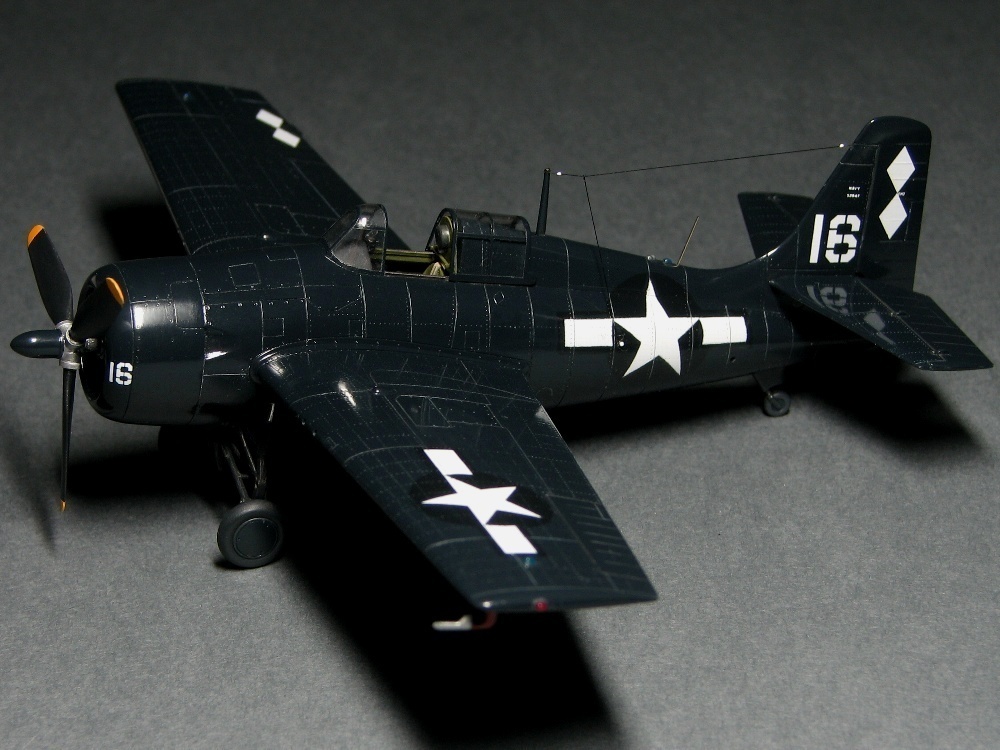 |
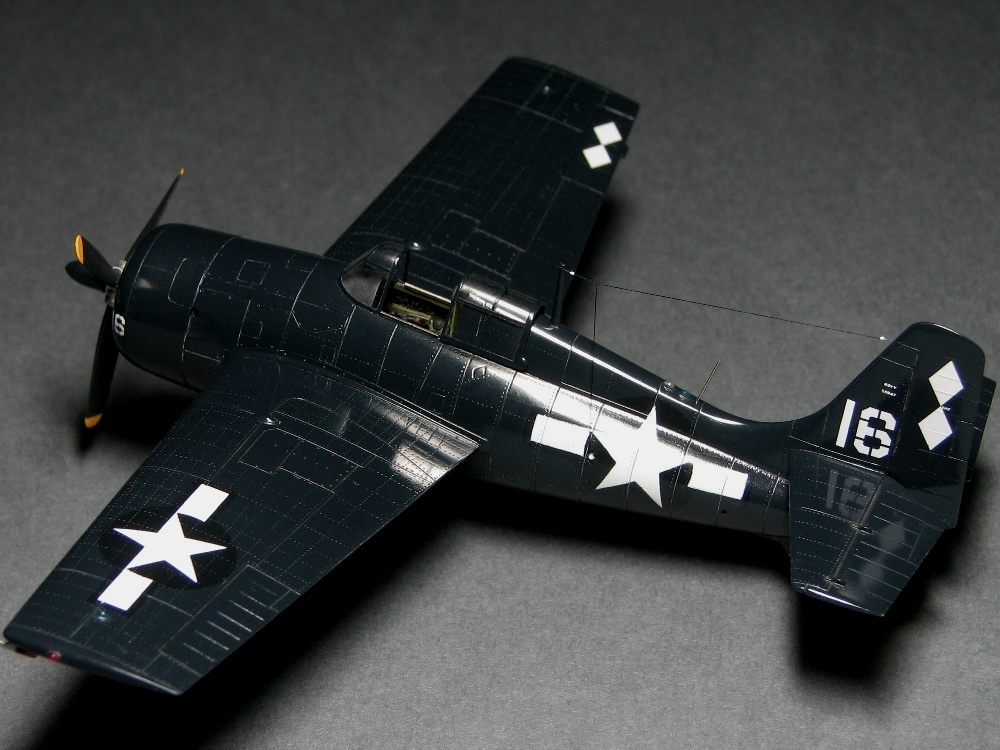 |
|
|
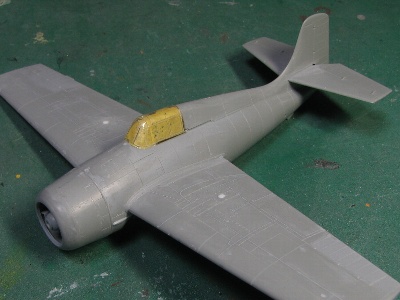 The small blister was made of styrene sheet. |
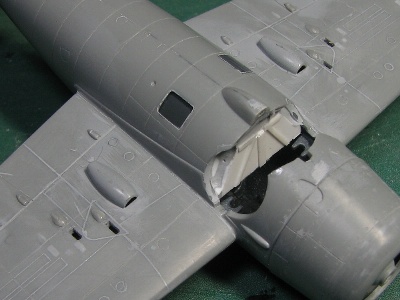 The bulkhead was added on the gear house. |
|
|
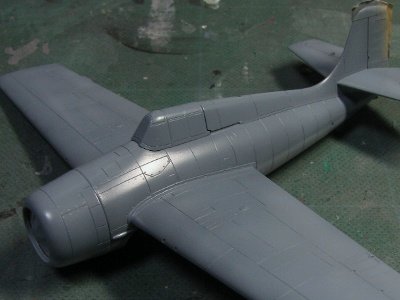 Blue Gray for the upper side is the mixture of #366 Intermediate Blue, #367 Blue Gray and #335 Medium Sea Gray with 1 : 1 : 2. Light Gray for the lower side is FS36440. I painted a mixture of #338 Light Gray FS35495 and #335 Medium Sea Gray. |
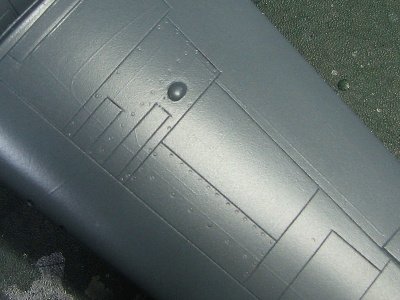 I used Tamiya Lacquer Putty for the filling of engraved panel line. In the result, whenever paint was sprayed on, putty became rising up. |
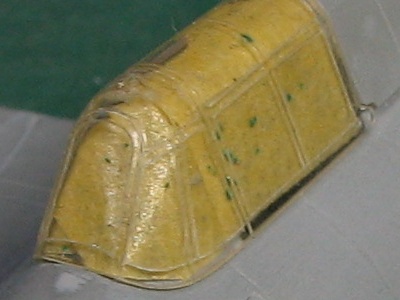 The front edge of the kit windscreen is vertically cut out. |
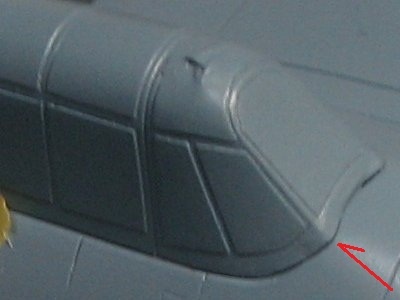 So I fixed it with CA glue and plastic powder. |
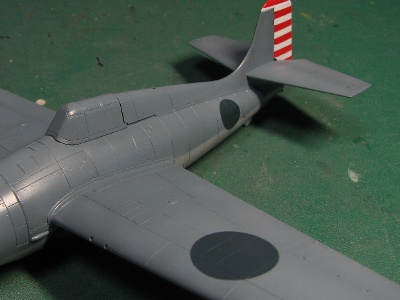 I don't like the Insignia Blue shade of decals in the marketplace. Faded Insignia Blue is a mixture of 50% Sea Blue and 50% Dark Sea Gray. Red and White stripes were painted as well. |
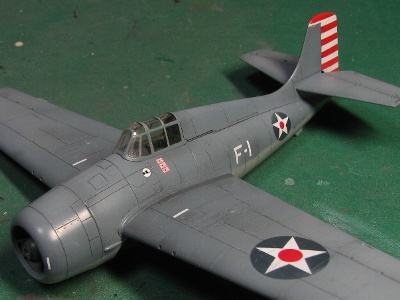 White stars and red circles were Aero Master Decals. The stars were cut from decals. The positions of port and starboard fuselage numbers are different each other. Aircraft numbers and personal markings were decals as well. |
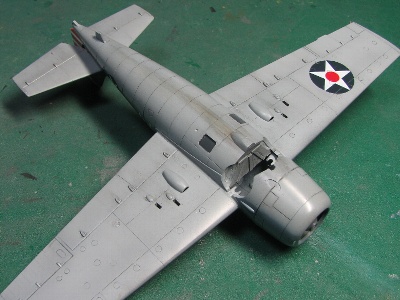 The position of the upper insignia is confirmed with the original photo. The lower insignia is supposition. |
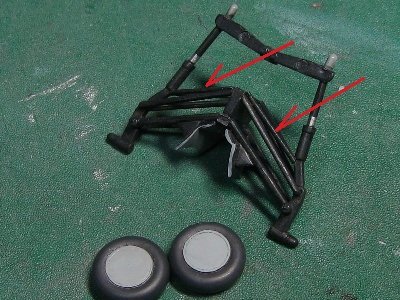 The landing gear was basically straight from the box. Some rods were added. |
|
|
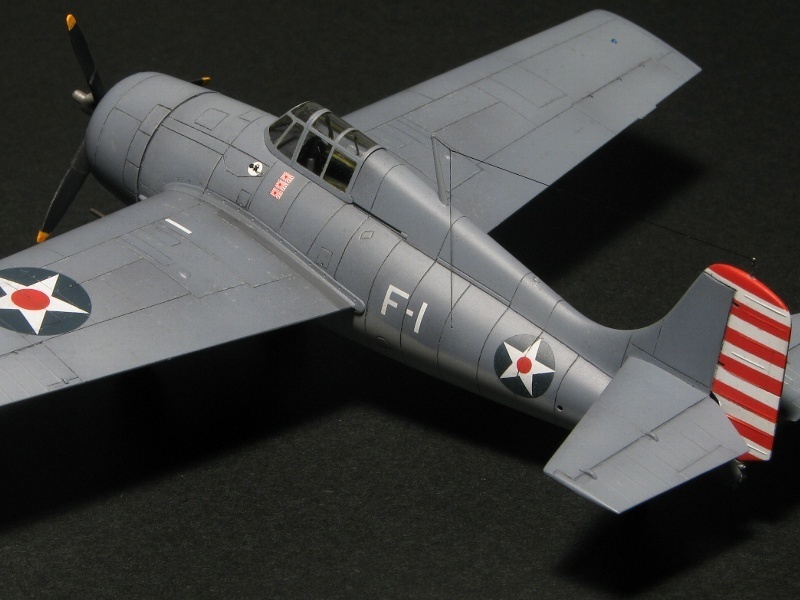 |
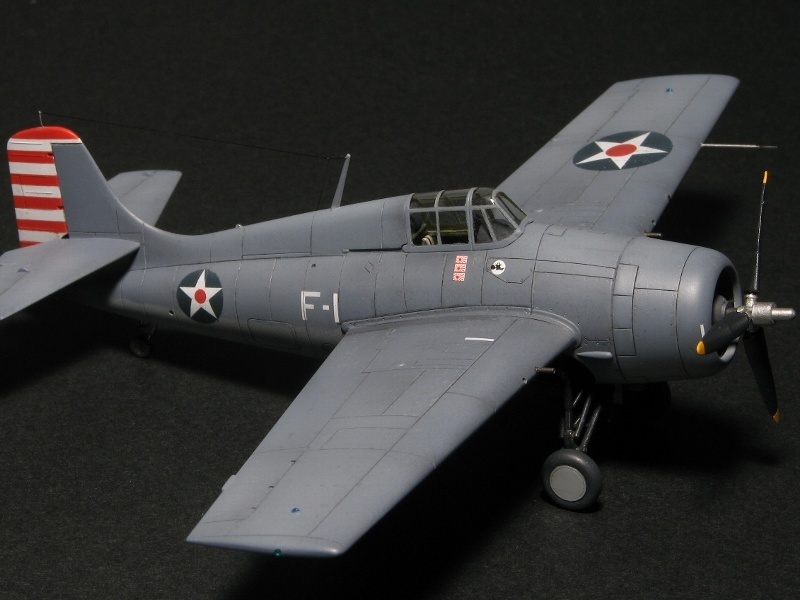 |
|
|
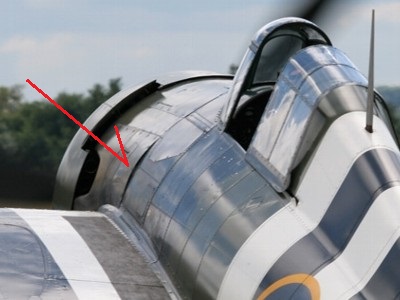 |
|
Mk.I features the Wright Cyclone R-1820 engine, no cowl flap, lip air intake on the cowl, Hamilton propeller, non-folding wing, two wing guns per each side, no tail hook fairing. The windscreen is located rearward and the slide hood is short. There are variations as for exhaust. The color profile is Mk.I of No 804 Squadron. Dark Slate Gray looks rather light in the original photo. The fuselage roundel is 36 inches size. The width of the yellow ring of the fuselage roundel is a half size of the original A-1 roundel. The upper and lower wing roundel is 40 inches A type. |
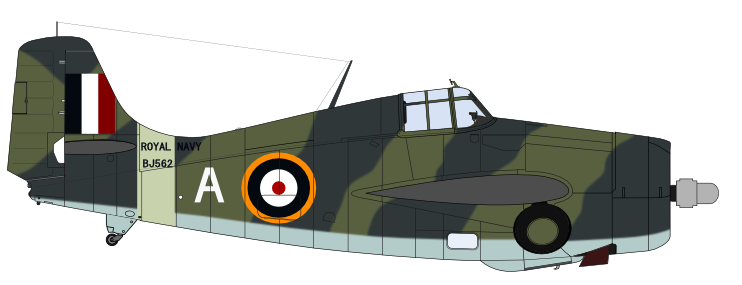
|
Martlet Mk.II Mk.II features the Twin-Wasp R-1830 engine, one cowl flap, no lip air-intake, Curtiss propeller, shell shape spinner, folding wing, three guns, and the additional window frame on the windscreen. Some Mk.II has a "7" shape pitot tube on the port wing. The color profile is Mk.II AJ132 code B of unknown squadron. The proportion of the fuselage roundel is anomalistic. The lower wing roundel is 40 inches A type and its center is 50 inches from the wing tip. Upper roundel is guessed that 40 inches B type. |
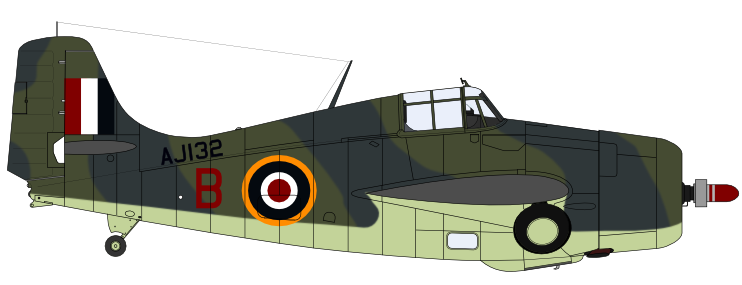
|
Martlet Mk.III Mk.III is the same as F4F-3A. That is, Mk.III features the Twin Wasp R-1830 engine, one cowl flap per each side, lip air intake, Curtiss propeller, step shape spinner, non-folding wing, two wing guns, and the additional window frame. Mk.III was originally produced as F4F-3A to export to Greece. However, as the surrender of Greece, these F4F-3As were received by FAA and renamed. The color profile is Mk.III of No 805 Squadron in North Africa. The US Navy serial is painted. The overall color is US Light Gray. The lower wing roundel is about 50 inches size A type and its center is 80 inches from the wing tip. The upper roundel is unknown but guessed B type and the same size and position. Lately, the tropical land scheme (Dark Earth / Middle Stone) was over painted. |
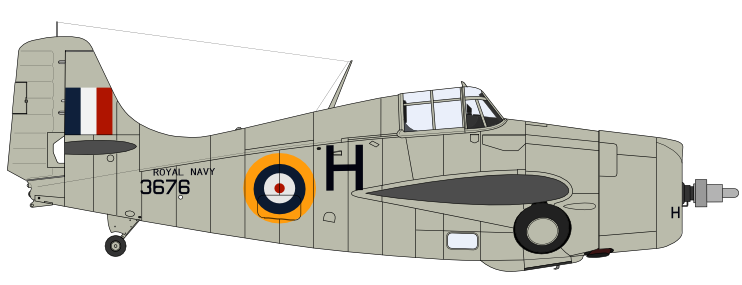
|
Martlet Mk.IV Mk.IV features the Wright R-1820 engine, one cowl flap (the position is higher than Mk.II and III), no lip intake, Hamilton propeller, folding wing, and three wing guns (the wing is the same as F4F-4). This profile is Mk.IV FN114 code φ9*F belonging No 893 Squadron of HMS Formidable in the Mediterranean. |
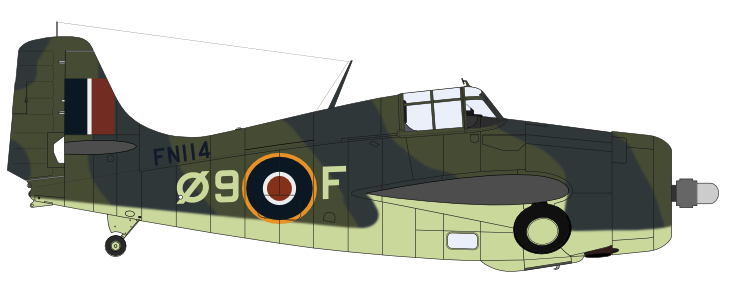
|
Martlet Mk.V(renamed to Wildcat Mk.V) Mk.V is the same as FM-1. Thus, it is almost same as F4F-4 except for the two wing guns. Mk.V features the Twin-Wasp R-1830, four cowl flaps, lip air intake, Curtiss propeller, step shape spinner, folding wing, and two wing guns. There are variation as for the antenna pole, tail wheel, rear view mirror, and the IFF antenna. The color profile is Mk.V code B belonging No 846 Squadron of HMS Tracker. The serial is unknown. The DD stripe is painted on both upper and lower wing. The upper wing filet is painted white (sorry, my profile is mistaken). Note differences of the antenna pole, mirror, navigation light, IFF antenna, and the rear wheel. |
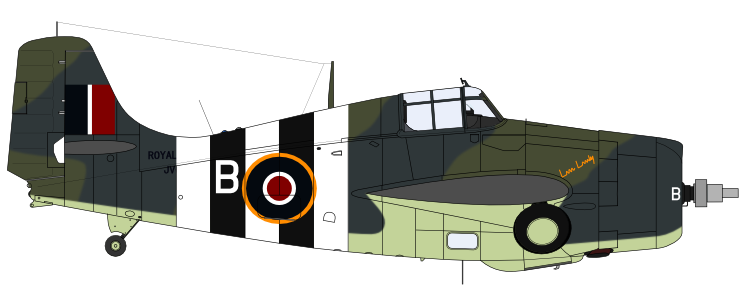
|
Wildcat Mk.VI Mk.VI is identical to FM-2. It features the Wright R-1820, no lip air intake, Curtiss propeller, folding wing, two guns, extended tail fin, and removed wing oil cooler. There are variation as for the position of antenna wire on the tail fin, exhaust gate, spinner, and the bullet proof plate. The color profile is Mk.VI of HMS Queen No 853 Squadron. The fuselage roundel is 36 inches. The upper wing roundel is C type 54 inches. The serial number is unknown. My color profile is fictional. The color of the fuselage code letter might be yellow as illustrated in Warpaint. |
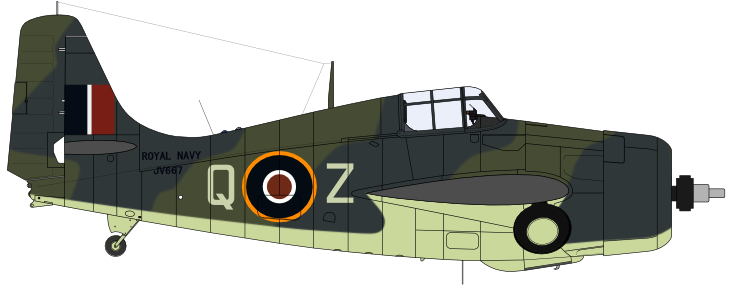
|
Serial numbers Mk.I AL236-262,AX725-738,AX824-829,BJ507-527,BJ554-570 (81)Mk.II AM954-999,AJ100-153 (100) Mk.III AX725-747 (USN3875-3940) (30) Mk.IV FN100-319 (220) Mk.V JV325-636 (311) Mk.VI JV637-924,JW785-836 (340) The comparison of short nose models The following figure shows the comparison of Mk.I, IV and VI. Note the rear end of the cowling and the position of the windscreen. |
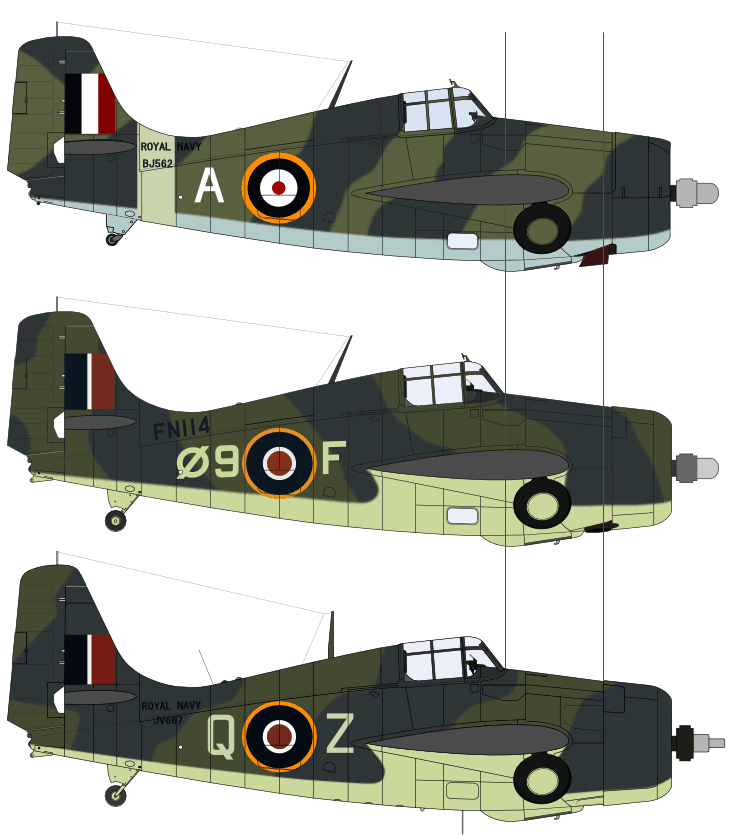
|
In general, there are three main types of Temperate Sea Scheme camouflage patterns as for Martlet Mk.I through Wildcat Mk.VI. Basically, Mk.I is independent, Mk.II and IV are the same pattern with each other, Mk.V and Mk.VI are the same as well. Mk.III is painted US Light Gray and the Temperate Sea Scheme is not applied. Mk.I The camouflage pattern is shown in Grumman's official figure 23350-3. This pattern is confirmed by original photos. At first, Mk.Is were painted with Gross Sea Green 28, Gross Flag Blue 24 and Gross Light Blue 27 under surface. When Mk.Is were delivered into FAA, the upper surfaces were repainted with Extra Dark Sea Gray and Dark Slate Gray, but the under surfaces were remained. When White / Night under surface was introduced to the RAF, Martlet Mk.I might be repainted as well. The following starboard figure shows Mk.I of No 804 Squadron. The port figure shows US original paint scheme. |
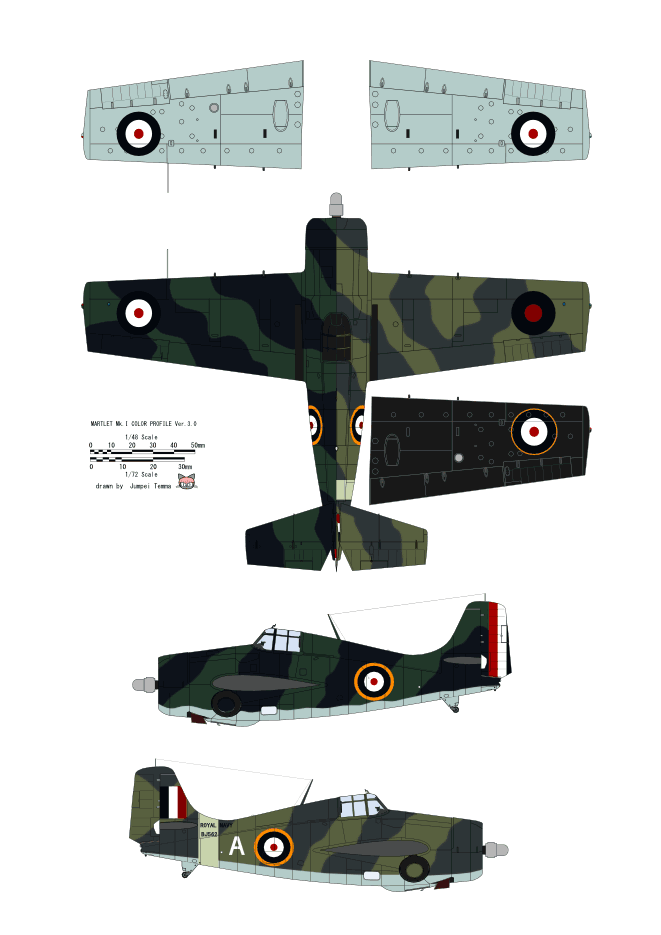
|
Mk.II & IV The camouflage pattern is shown in Grumman's figure 23350-6. The basic pattern is common in Mk.II and IV. The upper and lower roundel size is described as 54 and 51 inches. However, most of actual aircraft had 40 inches size. The fuselage roundel was 42 inches A-1 type or 36 inches C-1 type. Some Mk.IV had a large (54 inches?) upper wing roundel and A-1 type fuselage roundel. The position and size of the serial number is common in Mk.II and IV as well. The following figure shows as Mk.IV, and Mk.II is the same pattern. Different size and position of each roundel shows variations. A few Mk.II might be inverted coloration. The red figure in the port wing shows the location of "7" shape pitot tube and the green figure shows its sideview shape. |
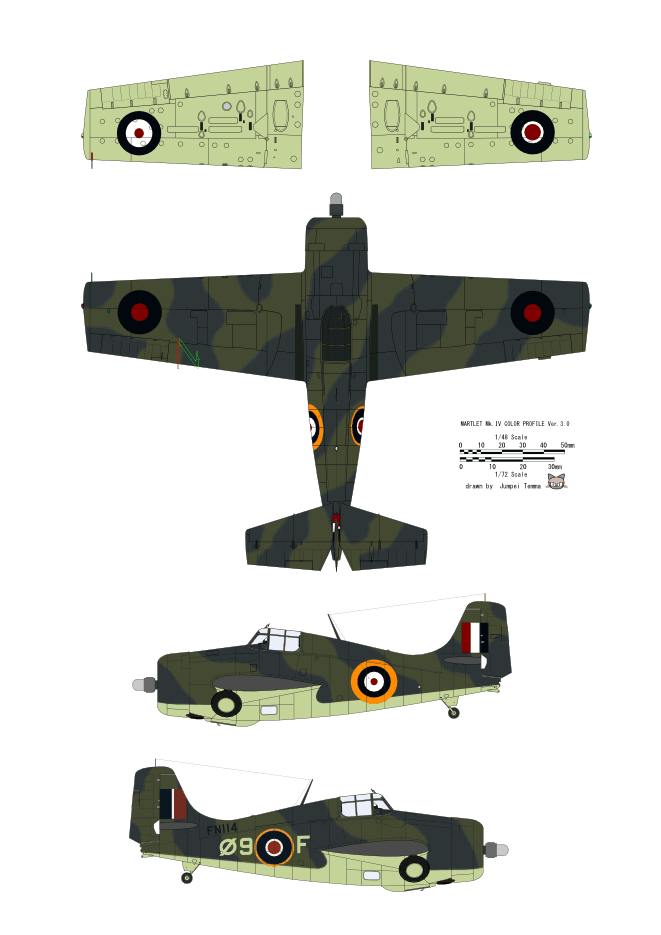
|
Mk.V & VI I couldn't find an official figure for Mk.V and VI. So the camouflage pattern is drawn from original documentary photos. The basic pattern was common in Mk.V and VI. The coloration is confirmed by the original color photo. The upper wing roundel is 54 inches and its center is about 80 inches from the wing tip. The lower roundel is 32 inches, the fuselage roundel is 36 inches, and the fin flash is 24 X 24 inches. |
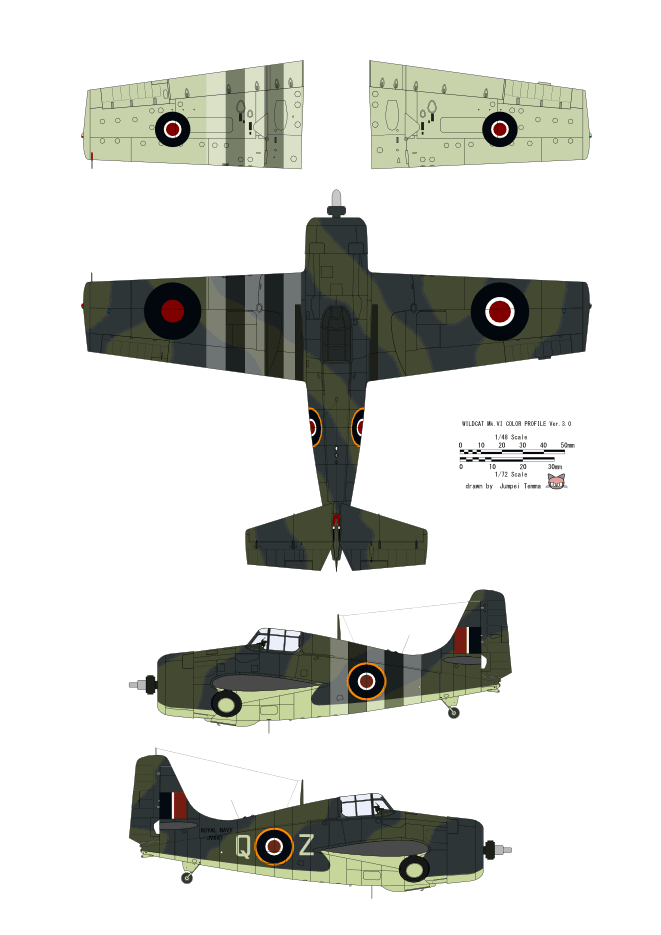
|
|
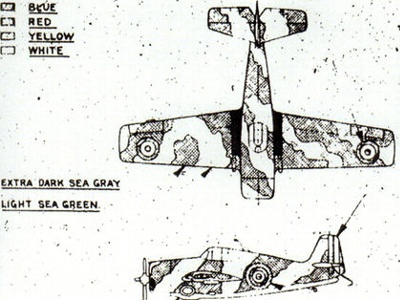 This figure is Grumman 23350-3 for Martlet Mk.I. |
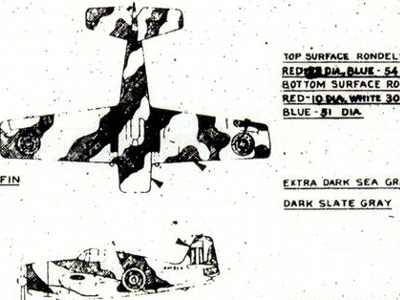 This one is 23350-6 for Mk.II and IV. |
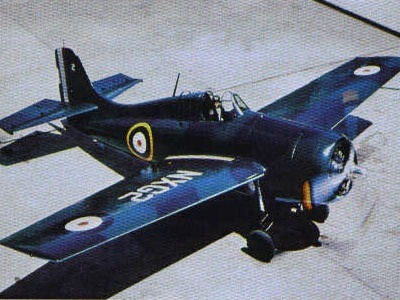 This G-36A (Martlet Mk.I) is painted original US color scheme (Sea Green 28, Flag Blue 24). Note the propeller tip is painted tricolor. |
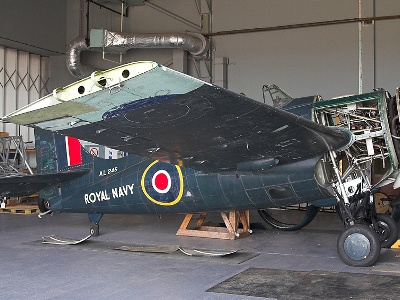 This is the existing Martlet Mk.I. Original Light Blue 27 is seen on the starboard wing. |
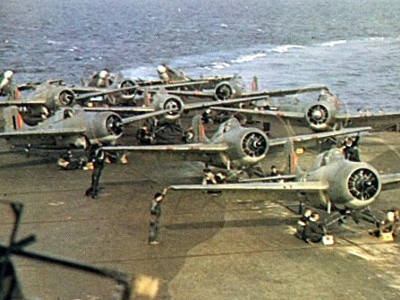 These aircraft are identified as Mk.IV by the cowl lip (no intake) and Hamilton propeller. The starboard side of the cowl looks like green. |
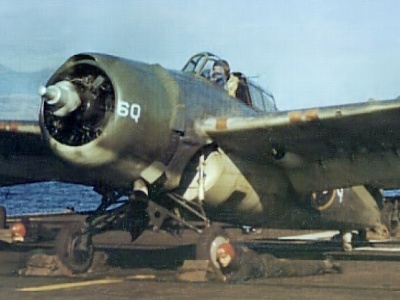 This is Martlet Mk.V. The port cowl is painted with Dark Slate Gray. This aircraft has small rear wheel and no antenna pole. The gear house is painted with very light color (Sky?). |
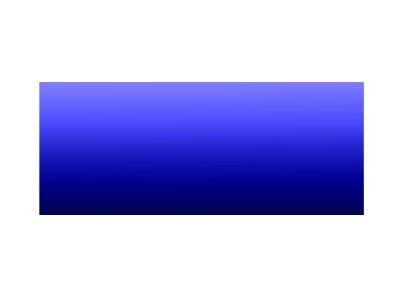 |
|
It is passably recognized as a cylinder. But, the surface looks like matte. So I consider about a mechanism of light and reflection. The left figure shows reflection on a cylinder. A source of light is above the cylinder. An observer stands on the left side of the cylinder. As this figure, the top highlight is 45 degrees plane and the downward 45 degrees plane is the darkest. |
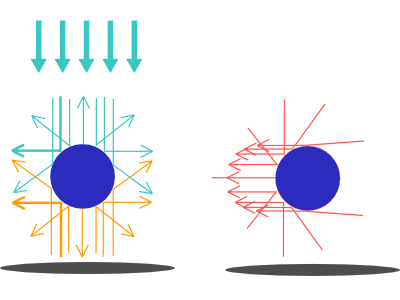 |
|
The right figure shows departure points of observed lights (pink lines). The upper edge reflects the light from the opposite side of the cylinder. The following figure is illustrated with these effects. The surface looks like semi-gross or satin-gross. When I illustrate a color profile, I have this mechanism in the back of my head. |
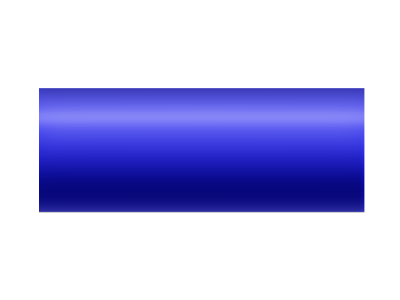 |
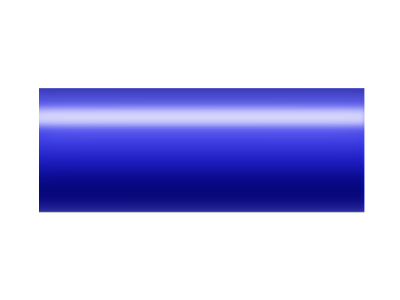 |
|
|
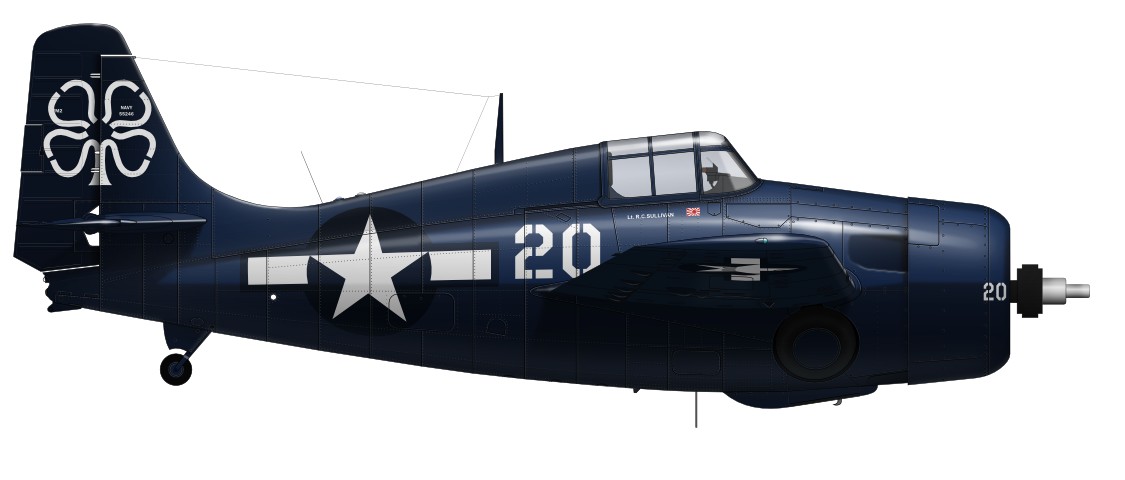
|
Next one is the anti-submarine scheme FM-2 of unknown squadron. However, VC-36 of USS Core CVE-13 in the Atrantic of 1944 is the similar scheme and marking style. So it might be this squadorn. |
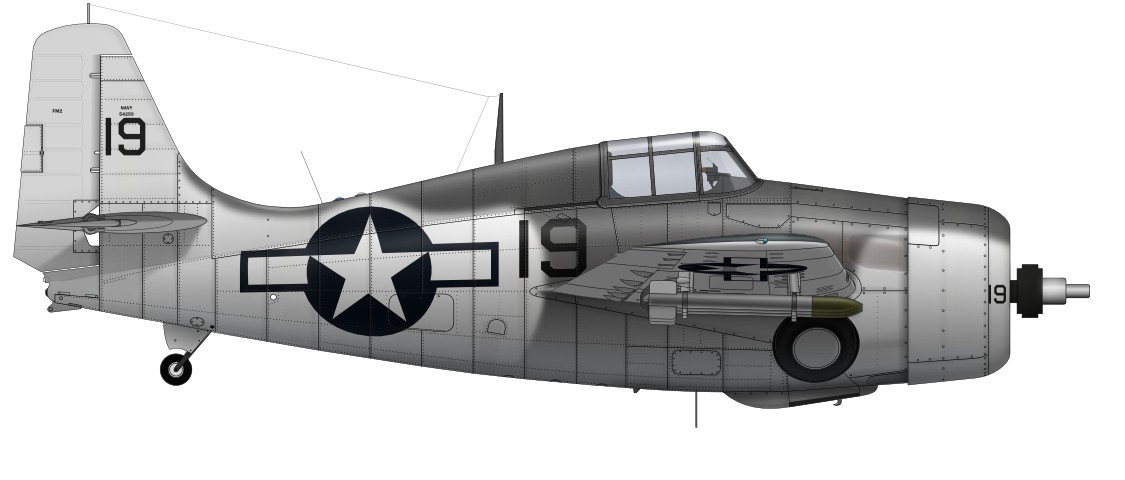
| FAA's Wildcat Mk.VI is No 853 squadron of HMS Queen in 1945. The serial number is unknown. My profile is fictional. The upper roundel is 54 inches C type. The color of the code letter might be yellow according to WarPaint. My profile is just a supposition. Both aircraft feature characteristics of the early production model. |
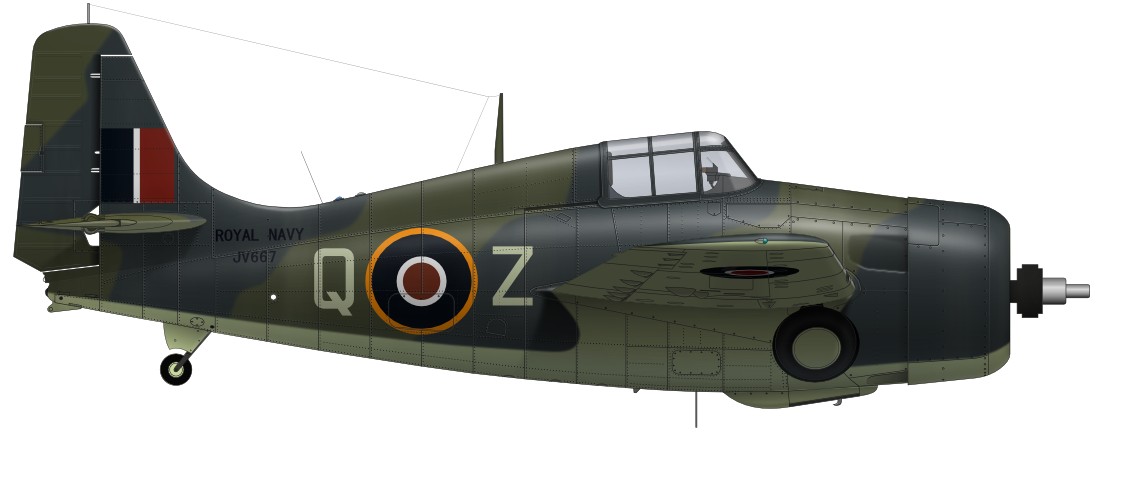
|
F4F-3 BuNo 3976 flown by Lt. Com. John Thach. Note that the position of the starboard letter is a little different from the port side. The demarcation line of fuselage camouflage is unusual. I think this aircraft had been finished in overall light gray and blue gray was painted lately. The second profile is BuNo 3986 flown by Lt. O'Hare. Details of the markings of his aircraft have a supposition. |
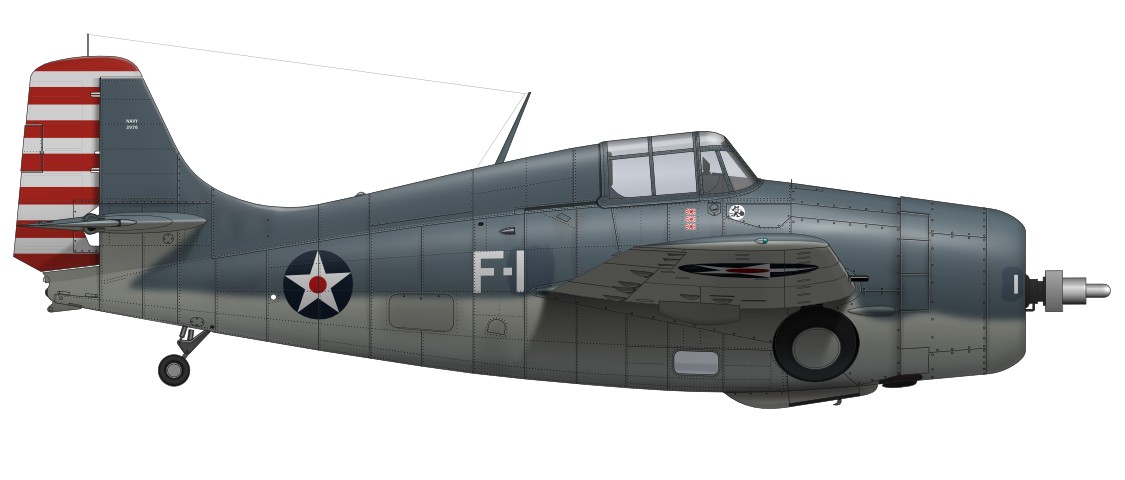
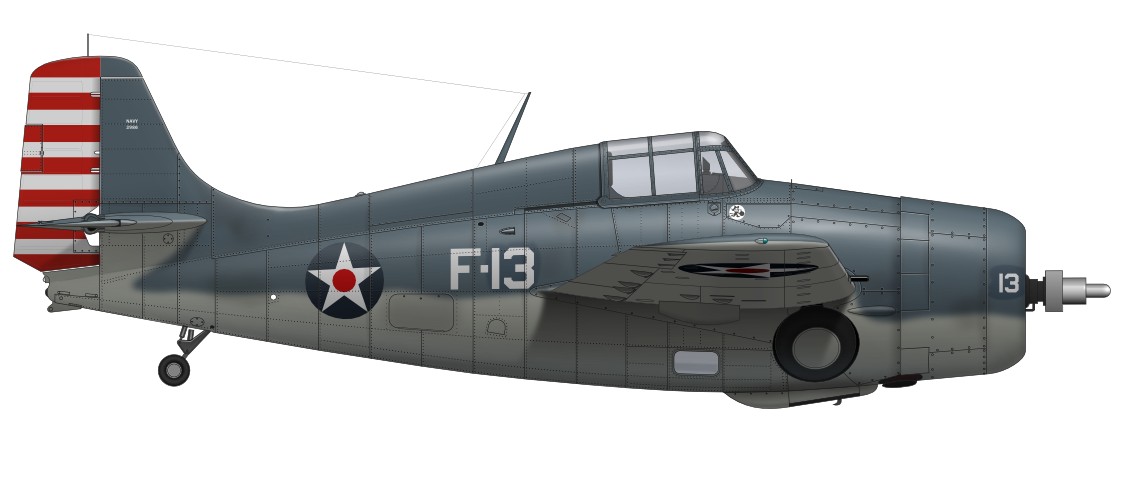
|
Yellow wing F4F-3s had been appeared since December of 1940 until March of 1941, and delivered to only VF-4 of USS Ranger CV-4 and VF-72 of USS Wasp CV-7. Thus, tailfins were painted only green (Ranger) and black (Wasp). Markings of this period (the color of the cowling, fuselage band, wing band, code letters) were systematic. These are described in "Golden Wings 1941-1945 / Squadron Signals ISBN 0-89747-294-2". |
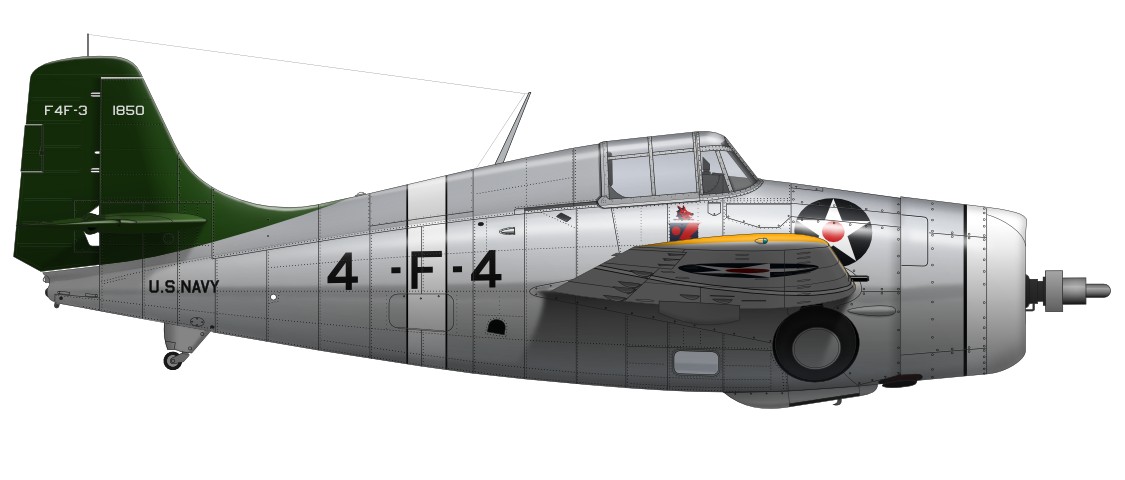
|
Martlet Mk.IV s/n FN114 code φ9*F belonging No 893 Squadron of HMS Formidable in the Mediterranean. Details of this color profile contain a little supposition. This aircraft features the IFF antenna line. |
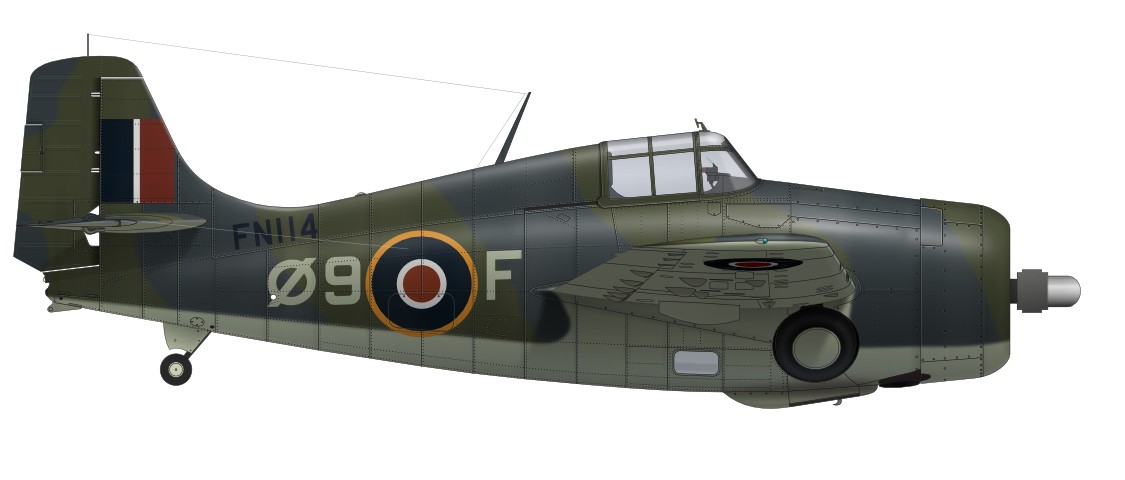
|
|
| 1 | The Famous Airplane Of The World (New Edition) No.68 Grumman F4F Wildcat ISBN 4-89319-065-2 | Bunrindo |
| 2 | The Famous Airplane Of The World (New Edition) No.35 Grumman F4F,F6F,F8F | Bunrindo |
| 3 | The Famous Airplane Of The World (Old Edition) 1971 No.16 Grumman F4F Wildcat | Bunrindo |
| 4 | Aerodetail 22 Grumman F4F Wildcat ISBN 4-499-22692-9 | Dainippon-kaiga |
| 5 | Osprey Ace Series No.8 Wildcat Aces of World War II ISBN 4-499-22742-9 | Dainippon-kaiga |
| 6 | Koku Fun Air Combat No.13 | Bunrindo |
| 7 | 'Veterans' Koku Fun Illustrated No.93 | Bunrindo |
| 8 | F4F Wildcat In Action Aircraft No.84 ISBN 0-89747-200-4 | Squadron/Signal Publications |
| 9 | F4F Wildcat In Action Aircraft No.191 ISBN 0-89747-469-4 | Squadron/Signal Publications |
| 10 | Walk Around 4 F4F Wildcat ISBN 0-89747-347-7 | Squadron/Signal Publications |
| 11 | D&S vol.30 F4F Wildcat ISBN 0-8306-8040-3 | Airlife |
| 12 | Warpaint Series No.9 Grumman F4F Wildcat | Warpaint Books |
| 13 | Monografie Lotnicze 20 F4F Wildcat ISBN 83-86208-29-5 | AJ-Press |
| 14 | Monografie 12 Grumman F4F Wildcat ISBN 83-89088-53-3 | Kagero |
| 15 | Fleet Air Arm British Carrier Aviation, 1939-1945 ISBN 0-89747-432-5 | Squadron/Signal Publications |
| 16 | Golden Wings 1941-1945 (USN/USMC Aircraft of World War II) ISBN 0-89747-294-2 | Squadron/Signal Publications |
| 17 | U.S.Navy Carrier Fighters Of World War II ISBN 0-89747-194-6 | Squadron/Signal Publications |
| 18 | Carrier Air War In Original WWII Color ISBN 0-87938-983-4 | Motorbooks International |
| 19 | U.S.Navy Fighters Of WWII ISBN 0-7603-0559-5 | MBI Publishing Company |
| 20 | Britain's Fleet Air Arm In World War II ISBN 0-7643-2131-5 | Schiffer Military Histor |
| 21 | On Target Special No.2 Britain Alone ISBN 1-904643-06-X | The Aviation Workshop Publication |
|
|

|